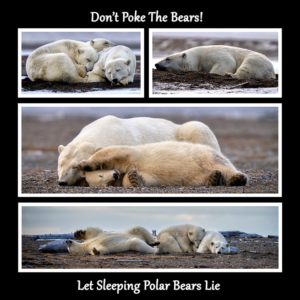
A regularly scheduled flight to Fairbanks was the first leg, but the second half of the trip required the use of a smaller bush plane, which actually made the this leg of the trip more interesting as we flew through some very scenic mountain ranges before arriving at our final destination on the edge of the Beaufort Sea.
Our pilot said that the weather conditions at our destination were near perfect for this time of year, and we even spotted a polar bear on one of the barrier islands as we made our landing approach! Indeed we were very lucky the first few days before it turned much more windy and colder.
Three Hundred Fifty a Night for Accommodation Doesn’t Buy Much up Here
This particular village on the Beaufort Sea is quite small, with less than three full time hundred residents, most of whom are ethnic Iñupiat. The town’s history as a permanent settlement only goes back to the 1950’s when a Distant Early Warning (DEW) line station was established there, but the area was long established before then as a traditional fishing location, and was also used for bartering and trade in the nineteenth century. The houses in town are generally quite small (less area to heat), so the residents tend to keep some of their possessions in their front yards (snowmobiles & ATV’s, dog sleds etc.).
With only three hotels at the time I visited, the range of accommodation was fairly narrow. I stayed at the one of the main places, whereas others who were on a tighter budget stayed at a bed & breakfast (which didn’t really offer any breakfast or food for that matter), and the amenities were in the vein of the faucet handle in the bathroom being a pair of vice grips. In contrast, my accommodation was somewhat luxurious, in that they had a full kitchen with quite decent food, and the rooms were somewhat Spartan but functional, and I did have a private bathroom with a shower. My stay wasn’t entirely without incident though, one night I was wondering if I was going to have to seek out a warm polar bear to hug in order to keep my body temp up, and there were a couple of other accommodation “challenges” thrown in to add to the overall adventure.
“Golden Hour” All Day Long
Photographers often seek out a time of day called the “golden hour”, that hour just before sunset when the sun is very low, and the tone of the light is very warm, as it is the ideal light in many circumstances. By virtue of this location being above the Arctic Circle, and it being October when I visited, it is essentially “golden hour” all day long as the sun is almost hanging in the sky at less than 15 degrees maximum elevation.
 The Curious Cub
The Curious Cub
Being able to safely get close enough to the bears (one still needs a long telephoto lens, as thankfully there are protocols and rules as to how close operators can get) made it much richer experience than just seeing a polar bear, as it was very easy to observe polar bear behaviour when they weren’t just snoozing.
Don’t Poke the Bear – Let Sleeping Polar Bears Lie

Although even when sleeping, the polar bears are both cuddly and endearing.
I loved these images of sleeping bears so much that I made up versions of the images that are optimized for printing on blankets and duvet covers (such as the one I now have on my very own bed). Don’t Poke the Bears – Let Sleeping Polar Bears Lie
Check back daily for additional posts in this eight part series, leading up to International Polar Bear Day on Feb 27th!

